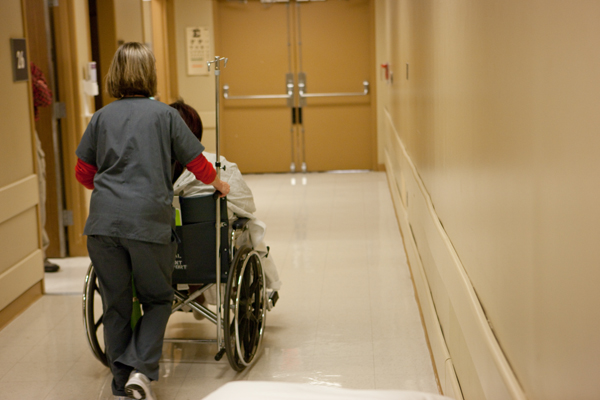







Standards of Performance Examples for Healthcare: Elevator Etiquette and Privacy

This blog post continues our series of HealthStream Coaching's patient experience best practices. Every week we share information from our coaches that demonstrates their expansive understanding of the challenges faced by healthcare organizations and the solutions they have identified for improving the patient experience and patient and business outcomes.
Standards of Performance can be used in numerous ways to help select applicants who are well suited to the healthcare organization's culture. As we look at best practices for using healthcare standards of performance, we will share some specific examples. This week we examine standards for elevator etiquette and privacy.
If you are at a facility that has an elevator, be sure to follow proper elevator etiquette. Always smile and speak with fellow passengers. Hold the door open for others.
When transporting patients in wheelchairs using an elevator, always face them toward the door of the elevator and exit with care. If transporting a patient in an elevator who is in a bed or on a stretcher, politely ask others to wait for another elevator. Pause before entering an elevator so you do not block anyone's exit. Step aside or to the back to make room for others.
Walk departing guests to the elevator.
Since elevators are often the primary means of transportation between floors in a healthcare organization, we are most likely to initially encounter our customers in this setting. It follows that observing the rules of elevator etiquette is a wonderful opportunity to create a favorable first impression.
As an elevator door opens, we should pause briefly before attempting to board so that we don't obstruct the way for people who are departing. Once inside, make room for others who are waiting to board and hold the door or press the "door open" button for them. We are expected to greet fellow elevator passengers in a friendly manner by making eye contact, smiling sincerely, and introducing ourselves. Experts tell us that communication is vastly influenced by our tone of voice. Remember that customers can easily pick up on friendliness - or not - in the voice that greets them.
We shouldn't monopolize space in the middle of the elevator so that we can exit quickly upon stopping; this behavior creates an impression of inconsideration on our part, and of a "me first" mentality. Allow patients and those with disabilities space by the elevator door.
Lastly, it is always, our responsibility to walk a customer to the elevator upon being asked for directions to it. As we accompany that person, we introduce ourselves with a sincere smile and ask if there is anything else that we can do for that customer, as a demonstration that "we have the time."
One last rule of high performance elevator etiquette: safeguard customer confidentiality. We never discuss patients, their care, or diagnostic treatment information on elevators. In order to preserve the integrity of our healthcare organization, we also refrain from gossip in this setting about customer's families, physicians, our leaders or coworkers. In addition, we should refrain from talking about sensitive hospital business or confidential data such as employee performance problems.
Privacy
Make sure that patient information is kept confidential. Never discuss patients and their care in public areas.
Knock before entering. Close curtains or doors during exams and procedures. Provide a robe or second gown if the patient is ambulating or in a wheelchair. Make sure all gowns are the right size for the patient.
Providing privacy in the healthcare environment is critical to high performance. First, we are mandated by law through HIPAA to protect the privacy of our customers' health information and records. Second, patient satisfaction surveys identify how well we demonstrate our concern for privacy, allowing us to make the necessary changes to fulfill expectations. Ours must be an environment of "no excuses" because we have the information we need to be accountable to patients. Finally, the HCAHPS initiative will tell potential customers whether or not they can expect their privacy to be respected if they choose our facility, thus directly influencing their decision.Patients have the right to modesty and privacy in personal care. We must always ensure that people receive treatment in a dignified way that does not embarrass, humiliate or physically expose them. By definition, modesty is about respecting our patients. The use of Words that Work helps the patient understand that their privacy is being respected.
Examples of Words that Work
I will shut the door while I take your health history so it can be kept private.
Here is an extra gown for you to ensure that you are properly covered while walking in the halls - I am concerned about your privacy.
I am pulling the curtain to ensure you have privacy during _____________.
Would you like the door/curtain closed so you can have more privacy?
I am putting this blanket over you while I take you to _________ so you will have more privacy.
Finally, our customers recognize and remember the behaviors that show consideration for their privacy. These actions foster trust because they inherently promote the patient's peace of mind and lessen anxiety about being in a place where dignity can be easily compromised. Trust helps bring down the stress level because the customer feels respected. Finally, showing that we have a high regard for our patients' privacy allows us to connect personally with them, thereby making a substantial difference in their healthcare experiences.
